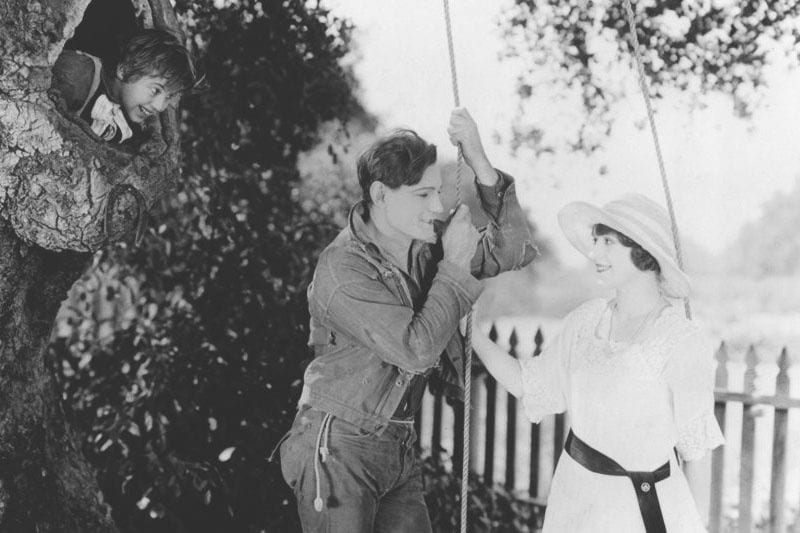

Grapevine is promoting made-on-demand DVDs featuring two of the most popular stars of silent westerns: Just Pals (1920) with Buck Jones, and The Calgary Stampede (Herbert Blaché, 1925) with Hoot Gibson. Both titles have been available before, so these count as reissues worthy of attention.
Although Just Pals has been described as a western in various references, including Wikipedia, it truly isn’t one. While set in a town on the border between Wyoming and Nebraska, it belongs to the school of contemporary small-town sentimental melodramas current at the time, and it’s a downright excellent example.
Directed by John Ford (billed as Jack Ford) in his first film for Fox, Just Pals is the kind of silent tale in which simple, even naïve emotions are handled with complexity and depth that give the film power. Jones plays Bim, “the town bum” and general shiftless laughing-stock. His nobility is revealed in gestures that don’t usually pay off, such as when as he defends a little boy (Georgie Stone) from a violent railroad bull, as the private security officers were known.
Bim and young Bill become fast friends in a town with little or no social services to regulate children without guardians, and their deep instant love for each other as fellow outcasts is one of the story’s primary motivations. Nobody thinks it strange that a homeless boy hooks up with the town bum, but tongues wag that the boy ought to go to school, even though nobody suggests taking him in to their home.
A parallel plot involves the schoolmarm (Helen Ferguson), who gets into financial trouble over her supposedly respectable boyfriend (William Buckley). They belong to a brew of small-town characters with moral flaws and cross-purposes, including the comical sheriff (Duke R. Lee) and the doctor (Edwin B. Tilton).
The town and mob mentality take quite a few hits in a plot that includes a threatening lynch mob before things are squared away. The tone and plot complications are often surprising and unpredictable, with many carefully observed vignettes providing pathos and comedy. The innocent or open-hearted emotions are balanced by a vision of very dark textures: greed, violence, poverty, cruelty, and perhaps worst of all, indifference. This makes a fascinating entry in Ford’s Americana genre.
In short, it’s a beautiful job, and over in an hour. Our appreciation is aided immeasurably by an excellent print with a new score by David Knudtsen. While collectors may already have this film in the 2007 box Ford at Fox Collection: John Ford’s Silent Epics, it’s worth noting that Grapevine’s print is nicely tinted (as opposed to black and white) and has a different score.
Buck Jones shines as Bim. The camera loves him, and his acting is clear and natural. In a way, young Bill is the viewer’s surrogate, because we too are drawn to Bim’s charm and want to look out for him. It’s not surprising that Jones, a cowboy and stuntman, remained a charismatic western star into the talkies. He died in the infamous Cocoanut Grove fire of 1942 while reportedly trying to save others.
While Just Pals has a token scene or two where he rides a horse, it’s worth repeating that this isn’t a western by any stretch. It’s exactly the kind of sentimental tale that other movies placed in Southern or New England villages, and its picket-fence railroad town looks exactly like Andy Hardy’s, if we can imagine Andy Hardy facing a lynch mob.
Another major cowboy star of the era was Hoot Gibson, who established himself as a rodeo star in such major events as the Calgary Stampede, the annual Canadian rodeo exhibition that continues to this day. That event is the backdrop for the final act of the 1925 film named after it. Shot entirely in Alberta, the real purpose of this picture is to provide climactic documentary footage of various events in the Stampede as well as to provide a vehicle for Gibson.
Virginia Brown Faire and Hoot Gibson in The Calgary Stampede (1925) (poster)
As a story, The Calgary Stampede shovels together a passel of conventions already well-worn in its day, and which generally depend upon unreasonable behavior from all concerned. First, there’s the plot about how circumstances make our hero, Dan Malloy, appear guilty of killing his girlfriend’s angry daddy, when in fact it was another fella firing from the veranda.
While our hero gets a job under an assumed name, we launch into the plot about betting the ranch on the big race in the Stampede, in this case the “Roman” race where riders stand on two horses at once. Will Dan expose his true identity while saving the ranch? Will the half-breed French/Indian maiden confess that her polecat boyfriend is the real killer? Will the Canadian Mounties get their man? Oh, mother of mercy!
This movie looks like a soft, ragged 16mm print, which doesn’t enhance its appeal as a “Universal Jewel”, one of the studio’s high-budget prestige pictures. The location filming and the documentary spectacle account for its budget and special status as an attraction, along with the fact that Gibson was second only to Tom Mix as a cowboy star. Unlike Jones, Gibson’s appeal is somewhat untraditional, thanks to his smooth baby face and lack of obvious height. He became a star through his physical expertise and ability to radiate goodness.
The director is Herbert Blaché, who today is most famous as the estranged husband of pioneering woman filmmaker Alice Guy-Blaché. They came to America together and eventually parted ways into separate careers. Aside from capturing the action in some sweeping horse chases, he includes a couple of shots where the camera travels ahead of riders for invigorating effect. Even so, this plot and this print don’t make any special case for his artistry. As with Just Pals, Knudtsen provides a new organ score.
The following clip from Just Pals doesn’t reflect Grapevine’s tinted print but does show Ford’s eye and Jones’ charm.



